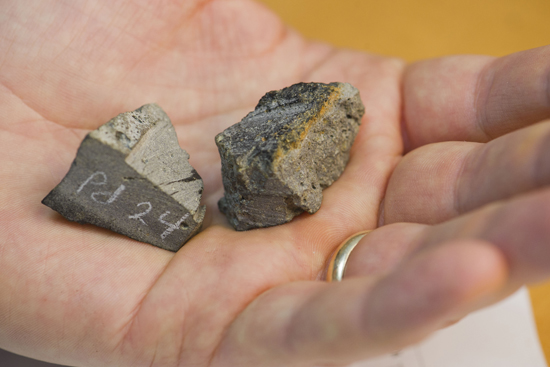Little Rock at Center of Big Controversy
CAS geologist shakes up field of geology

In an office on Commonwealth Avenue sits a small rock that is shaking geology to its core. About an inch long, gray and a little chalky, to the untrained eye it’s indistinguishable from any other lying on the sidewalk. It’s a small piece of basalt, derived from some of the Earth’s oldest mantle, the big green rock between the core and the crust that makes up most of the planet. And the work of Matt Jackson has catapulted this 62-million-year-old chunk of rock into the middle of a scientific controversy. “Basalts in general look pretty boring,” says the College of Arts & Sciences assistant professor of earth sciences. “It’s what’s inside that’s interesting.”
Jackson’s work revolves around a big question: how was the Earth formed? Specifically, he studies the formation of Earth’s mantle. The story of the mantle is the story of the planet, and since the 1970s geologists have generally shared the same theory about Earth’s beginnings. About 4.5 billion years ago, they say, a hot cloud of swirling interstellar dust compressed at the center, becoming our sun. Around the sun, gas and dust began to aggregate into rocks called chondrites, and then planetoids, then planets.
Early in the history of the solar system, the chondrites were richer in radioactive metals like plutonium (now extinct), uranium, and thorium. The heat from these radioactive metals, combined with the heat of collision, turned early Earth into a molten ball. Eventually, the dense element iron, and iron-loving elements like nickel and gold, settled out and became Earth’s core. Everything left became the primitive mantle, and eventually Earth’s crust formed on top.
Plenty of chondrites, some of the oldest and most primitive objects in the solar system, are still floating around in outer space. When they crash to Earth as meteorites, scientists gather and study them. If the theory of Earth’s formation is correct, then both Earth’s mantle and chondrites should be made of basically the same stuff, with the same ratios of various radioactive isotopes. And for decades, this seemed to be the case.
Then, seven years ago, researchers at the Carnegie Institution for Science, in Washington, D.C., made a remarkable discovery. They had found a new method to very precisely measure an isotope called neodymium-142, and when they used it on chondrites and mantle rocks, they were surprised to find that samples of chondrites and mantle didn’t match. Rocks from the mantle were surprisingly richer in neodymium-142. This means that Earth’s mantle didn’t form as scientists thought.

Most people may hear this news and say, “So what?” But to geologists the data was electrifying. The discovery was published in Science in 2005. Jackson was working on his PhD at the time and got excited when he read the paper. “I knew the discovery was going to be important, but I didn’t know how,” he says. “I just followed my nose. The discovery opened a Pandora’s box, and it was awesome.”
Why? For decades, geologists have assumed that the Earth formed from chondrites, and all estimates of the origin and evolution of the mantle and crust have been based on this assumption. “This is what the whole thing is built on,” says Jackson. “But what if we’ve been looking under the wrong rock the whole time, and the Earth isn’t chondritic?” Such an idea, which is what Jackson is suggesting, would represent a huge paradigm shift in geology.
After the 2005 Carnegie Institution discovery, Jackson joined the team there with a postdoctoral fellowship, then came to Boston University. He has methodically built on that early work and made some startling discoveries that question our understanding of how the Earth’s mantle works.
He focused on certain ancient volcanic rocks from Canada’s Baffin Island and nearby West Greenland, called flood basalts. Flood basalts were formed by massive outpourings of magma from Earth’s mantle millions of years ago. “It was unlike anything humans have ever witnessed,” Jackson says.
He first used the known difference in neodymium-142 between chondrites and Earth rocks to make specific predictions about other isotopes of neodymium in the ancient, primitive Earth. The Baffin Island basalts matched his predictions perfectly, surprising him. He found that the isotopes of lead in the basalts, as well as unusual ratios of helium isotopes, were also consistent with melting of an ancient, possibly primordial reservoir deep within the Earth’s mantle that has survived intact for most of the planet’s history. In research published in Nature in 2010, Jackson reported his discovery. According to these measurements, the mantle that melted to make the Baffin Island flood basalts—in addition to other major flood basalts around the world—is about 4.5 billion years old.
Jackson proposes that that mantle formed then, shortly after the Earth itself, somehow persisting undisturbed until it melted and erupted lavas 62 million years ago. (Other flood basalts around the world, which erupted at different times, seem to share these characteristics of primitive mantle, Jackson reported in Nature in 2011.) This idea is surprising and controversial, since scientists have long assumed that the mantle has been so scrambled by convection and partial melting that no remnant of the primordial mantle exists. But maybe, says Jackson, the Earth has somehow squirrelled away reservoirs of primitive mantle that formed the flood basalts like those of Baffin Island. “Half the geologists love the work, half the geologists hate it,” says Jackson. “There’s no middle ground.”
Jackson has much work ahead to bolster his findings: more tests on more flood basalts and on some chondrites too, he hopes. “Everything has been built on a house of cards,” he says. “Maybe I’m just building another house of cards, but I want to follow it and see where it goes.”
Barbara Moran (COM’96) is a science writer in Brookline, Mass. She can be reached through her website WrittenByBarbaraMoran.com.

Comments & Discussion
Boston University moderates comments to facilitate an informed, substantive, civil conversation. Abusive, profane, self-promotional, misleading, incoherent or off-topic comments will be rejected. Moderators are staffed during regular business hours (EST) and can only accept comments written in English. Statistics or facts must include a citation or a link to the citation.